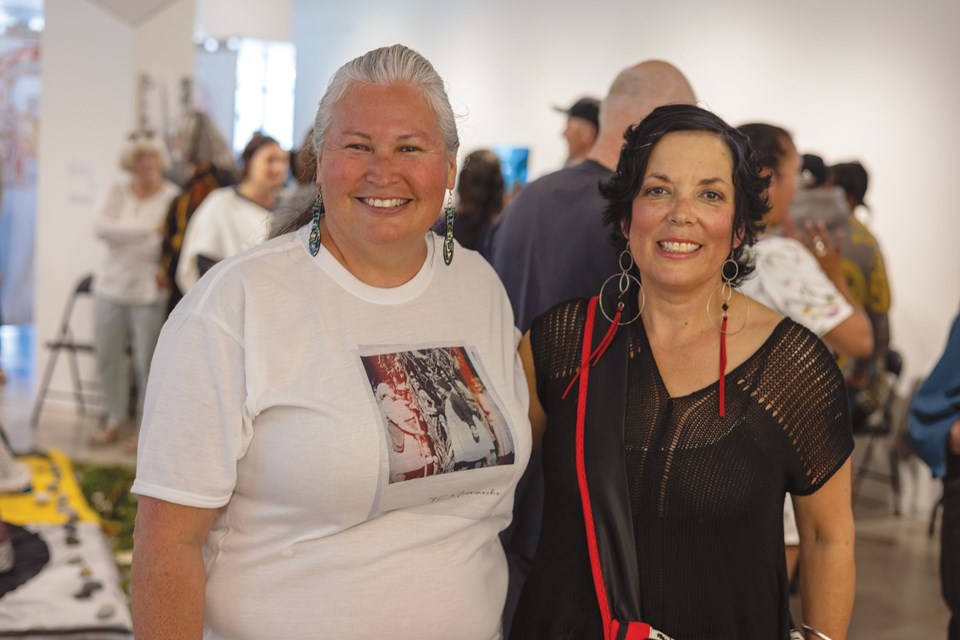The newest exhibition at the Gibsons Public Art Gallery projects the spirit of abundance in the West Coast potlatch tradition. The showcase of images, sculpture, textiles and multimedia opened on May 30 with a reception and salmon feast for more than 150 attendees hosted by co-curators xets’emits’a (Candace Campo) and Sandy Buck.
Artist Trent Maynard, photographer David Moul, painter Jess Hart, and multidisciplinary creator hazel bell-koski also attended to introduce their works.
“We look at art not through an individual [perspective] but art as the collective,” said Campo. “We see this show as a reflection of who we are and what we’re doing today.”
Campo, a shíshálh artist and entrepreneur, described one of her works as emblematic of the struggle to rebuild the vibrant culture of potlatch following its 66-year prohibition by the Canadian government. We Are Descendants of Matriarchs is a pointillist rendering in acrylic showing a gathering of Indigenous women gathering cedar roots. The feather-like periphery of the image fades into its blonde wood surface.
“We always honor our ancestors and honor our Elders,” said Campo. “They worked really hard to support their families when the potlatch was banned. We remember where we came from and we have deep love for our Elders.”
The influence of generations is apparent even in the materials Campo uses. Her luminescent abstract Unknown (Go Red) — a maelstrom of motion, with glimmers of fish smolt and solemn faces — was fashioned partly with acrylics and oil sticks, and partly with a granddaughter’s crayon. The four-legged subject of Thunder Frog wears a droll expression, but stolidly balances other living creatures on its back.
“We are here because of love, and that’s what’s going to get us through the healing,” explained Sandy Buck, co-founder of Deer Crossing the Art Farm and a Métis textile artist with a background in costume and puppetry. “I learned from my nana who did not grow up with stories. She was Métis but the words ‘Indian’ or ‘artist’ were never spoken in our household. So I grew up with all this hidden knowledge.”
Buck recalled her response when an aunt’s research revealed the family’s Indigenous lineage: “And I went, ‘Okay, that’s great. What do we do now?’”
A sculpted answer to Buck’s question is situated at the centre of the exhibition. Her Circle of Elders portrays four figures engaged in the essential act of potlatch: displaying and exchanging gifts. Their apparel is a blend of traditional weaving and contemporary accessories (one wears a ball cap). Cedar strips are piled atop a circular spiral of woven wood. Shells and green boughs surround the scene, proclaiming the largesse of nature. The moment, frozen in time, is simultaneously inviting and inaccessibly intimate.
hazel bell-koski’s silkscreened Flags for the Four Directions are part of a larger series that explores the interconnectedness between all living beings. The medicine wheel dominates her two-dimensional bestiary that flutters into action with passing air currents.
Her own mixed heritage blends Anishinaabe, Finnish, Irish and English cultures. “I make flags with people, with myself, and with animals that ask to be made into images,” she explained. Sometimes her animal subjects become impatient when the projects take too long: “They’re like, ‘Excuse me, we just want to be seen and honoured as part of this kinship.’”
A short film by videographer Tamar Kozlov (Potlatch pieces) provides insights into the significance of salmonberries and the ceremony of potlatch. Nearby, a canoe laden with luxuriant robes and carved paddles suggests that gift-giving itself may be transitory, but its effects ripple beyond one’s own horizon.
Preparing for the Potlatch, which also includes contributions by Jody Michael Clark and Talasay Campo, remains at the Gibsons Public Art Gallery until June 23.



